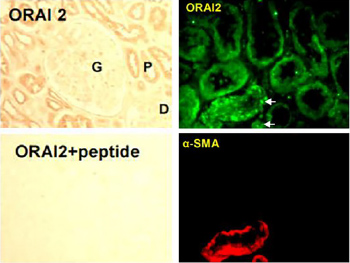Overview
- Peptide CPEPGHKGMDYRDWVRR, corresponding to amino acid residues 16-32 of mouse Orai2 (Accession Q8BH10). Intracellular, N-terminus.
- Jurkat (human acute T cell leukemia) and HL-60 (human promyelocytic leukemia) cell line lysates (1:200).
 Western blot analysis of human HL-60 promyelocytic leukemia (lanes 1 and 3) and human Jurkat acute T cell leukemia (lanes 2 and 4) cell lysates:1,2. Anti-Orai2 Antibody (#ACC-061), (1:200).
Western blot analysis of human HL-60 promyelocytic leukemia (lanes 1 and 3) and human Jurkat acute T cell leukemia (lanes 2 and 4) cell lysates:1,2. Anti-Orai2 Antibody (#ACC-061), (1:200).
3,4. Anti-Orai2 Antibody, preincubated with Orai2 Blocking Peptide (#BLP-CC061).
- Rat lung paraffin-embedded sections (1:100).
Cytosolic Ca2+ has long been known to act as a key second messenger in many intracellular pathways including synaptic transmission, muscle contraction, hormonal secretion, and cell growth and proliferation.1,2 The mechanism controlling intracellular Ca2+ level influx, either by the calcium-release-activated Ca2+ channels (CRAC) or from intracellular stores, has become of great interest.
Recently, several key players of the store-operated complex have been identified: the Orai family consisting of three members, Orai1-3, and the STIM family, which consists of two members, STIM1 and STIM2.3 Orai1 (also known as CRACM1) acts as the store-operated calcium channel (SOC) and STIM1 as the endoplasmic reticulum Ca2+ sensor.3,4 Orai1, Orai2, and Orai3 are all capable of forming store-operated channels.5
Co-expresssion of Orai2 and STIM1 was shown to produce currents that appear similar but smaller than those produced by co-expression of Orai1 and STIM1.6
Orai2 transcripts are predominantly expressed in kidney, lung, and spleen, and it appears that Orai2 is the only Orai isoform with multiple transcripts.7
Application key:
Species reactivity key:

Expression of Orai2 in human kidney.Immunohistochemical staining of human kidney sections using Anti-Orai2 Antibody (#ACC-061). In paraffin-embedded kidney sections, Orai2 is localized to kidney tubules, with stronger staining in the proximal tubules (upper left panel). Antibody preabsorbed with the blocking peptide (supplied with the antibody) was used as control to show the specificity of the antibody (lower left panel). In frozen kidney sections Orai2 staining is observed in renal tubules (upper right panel). Smooth muscle actin staining is shown in red (lower right panel).Adapted from Zeng, B. et al. (2017) Nat. Commun. 8, 1920. with permission of SPRINGER NATURE.
